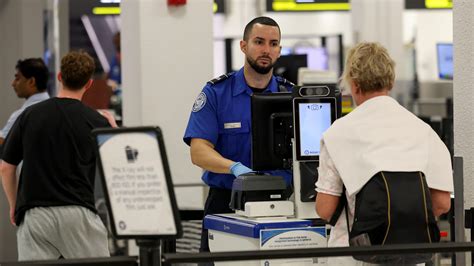
Travelers must now pack portable chargers, also known as power banks, separately in carry-on luggage, as the Transportation Security Administration (TSA) has implemented a new policy prohibiting them from being stowed away amongst other items. Failure to comply could result in confiscation. The TSA’s updated guidance aims to enhance safety by allowing officers to more easily inspect these devices, which pose a potential fire risk if damaged or defective.
The updated rule, quietly rolled out and confirmed by a TSA spokesperson, addresses concerns about the potential for lithium-ion batteries in portable chargers to overheat and cause fires during flights. The ability to quickly access and inspect these devices is paramount for TSA agents to determine the safety of passengers and the aircraft. Concealing power banks within tightly packed bags makes thorough inspection difficult and time-consuming. The new mandate focuses solely on carry-on luggage; there are no changes to the rules regarding power banks in checked baggage, though safety recommendations remain consistent across both.
“During the security screening process, TSA officers may instruct travelers to remove electronic devices from their carry-on bags for a closer inspection. This prevents unintentionally damaged batteries from going unnoticed,” the TSA stated, emphasizing the importance of visibility.
Lithium-ion batteries, ubiquitous in modern electronics, can be hazardous when mishandled or damaged. The Federal Aviation Administration (FAA) has long recognized the risk associated with these batteries, issuing guidelines for both passengers and airlines. These guidelines cover various aspects, including proper packaging, limitations on battery size and quantity, and restrictions on damaged or recalled batteries. The TSA’s new rule aligns with these broader safety concerns, adding another layer of precaution specific to the screening process.
The increased scrutiny on power banks comes as the demand for these devices continues to grow. Passengers rely on them to keep their smartphones, tablets, and other electronic devices powered during travel. This widespread use necessitates a proactive approach to mitigate potential risks. By requiring separate packing, the TSA aims to strike a balance between facilitating passenger convenience and ensuring safety.
The new procedure requires passengers to place power banks in a location within their carry-on bags where they can be easily viewed and accessed by TSA officers. This might involve packing them in a clear plastic bag, a dedicated compartment, or simply on top of other items. The goal is to allow for efficient inspection without the need to unpack an entire bag.
While the TSA has not explicitly stated specific penalties for violating the new rule beyond potential confiscation, non-compliance could lead to delays in the security screening process. Passengers who fail to follow instructions from TSA officers may be subject to additional screening measures, potentially causing them to miss their flights. It is therefore advisable for travelers to familiarize themselves with the new guidelines and pack their power banks accordingly.
The move reflects an ongoing effort by aviation authorities to adapt security protocols to address emerging threats and technologies. As electronic devices evolve and become more prevalent, the TSA and FAA must continually refine their procedures to maintain a safe and secure travel environment. The new rule regarding power banks is just one example of this proactive approach.
The updated rule also highlights the importance of passenger awareness and cooperation. Travelers play a crucial role in aviation safety by following guidelines, declaring potentially hazardous items, and reporting any suspicious activity. By working together, passengers and security personnel can help to minimize risks and ensure a smooth and secure travel experience for everyone. The ease with which a TSA agent can inspect a questionable power bank directly affects overall security.
The regulation’s impact on travel routines is anticipated to be minimal for most passengers. Regular travelers are accustomed to removing laptops and liquids for separate screening. This adjustment simply adds another item to that list, reinforcing the need for organized packing. However, some passengers may find the new requirement inconvenient, especially if they are not aware of the change before arriving at the airport.
The TSA’s implementation of the rule also necessitates increased training for security personnel. TSA officers must be equipped with the knowledge and tools to effectively identify potential hazards associated with power banks and to enforce the new packing requirements. This includes understanding the different types of lithium-ion batteries, recognizing signs of damage or defects, and knowing how to safely handle these devices.
The long-term effects of the new rule remain to be seen. It is possible that the TSA may further refine its guidelines based on operational experience and feedback from passengers and industry stakeholders. The agency is likely to monitor compliance rates and assess the impact of the rule on security screening efficiency.
This new rule doesn’t just affect domestic travel; it extends to all flights departing from U.S. airports, affecting international passengers as well. Awareness campaigns targeting international travelers are critical to ensuring compliance and avoiding confusion. These campaigns could involve multilingual signage, announcements, and online resources.
The TSA has faced challenges in communicating new policies to the public in the past. Clear and consistent communication is essential for the successful implementation of any new security measure. The agency must utilize a variety of channels, including its website, social media, press releases, and partnerships with travel industry organizations, to effectively reach its target audience.
The new rule regarding power banks is a reminder that aviation security is an evolving landscape. Passengers must remain vigilant and adapt to changing regulations to ensure a safe and secure travel experience. While the changes may seem incremental, they collectively contribute to a more robust security system. The TSA has not announced any specific changes to the rules regarding external hard drives or other electronic devices. The regulation specifically mentions power banks.
Frequently Asked Questions (FAQ)
-
What is the new TSA rule regarding portable chargers (power banks)?
- The TSA now requires passengers to pack portable chargers, also known as power banks, separately in their carry-on luggage so that they are easily accessible for inspection. These devices should not be buried amongst other items in a tightly packed bag.
-
Why did the TSA implement this new rule?
- The rule was implemented due to safety concerns related to lithium-ion batteries commonly found in power banks. These batteries can overheat and potentially cause fires if damaged or defective. Separating them allows TSA officers to more easily inspect the devices and identify potential hazards. As a TSA spokesperson stated, officers may instruct travelers to remove electronic devices from their carry-on bags for a closer inspection to prevent unintentionally damaged batteries from going unnoticed.
-
Does this rule apply to checked baggage as well as carry-on luggage?
- No, the new rule specifically applies to carry-on luggage. While there are no changes to the rules regarding power banks in checked baggage, safety recommendations remain consistent across both. It is still advisable to protect the device from damage and avoid packing recalled or damaged batteries in checked luggage.
-
What happens if I don’t comply with the new rule?
- Failure to comply with the new rule could result in your power bank being confiscated. Additionally, non-compliance could lead to delays in the security screening process and potential additional screening measures, possibly causing you to miss your flight.
-
How should I pack my power bank to comply with the new rule?
- You should pack your power bank in a location within your carry-on bag where it can be easily viewed and accessed by TSA officers. This could involve packing it in a clear plastic bag, a dedicated compartment, or simply placing it on top of other items.
-
What types of portable chargers are affected by this rule?
- The rule applies to all types of portable chargers, regardless of their size, brand, or capacity, as long as they contain lithium-ion batteries.
-
Does this rule only apply to flights within the United States?
- No, this rule applies to all flights departing from U.S. airports, including international flights.
-
Where can I find more information about this new TSA rule?
- You can find more information on the TSA website (www.tsa.gov) or by contacting the TSA directly.
-
Will the TSA provide clear plastic bags for power banks, similar to those for liquids?
- The TSA has not indicated that they will be providing clear plastic bags for power banks. Passengers are responsible for providing their own suitable packaging.
-
Is there a limit to the number of power banks I can bring in my carry-on luggage?
- While the TSA has not explicitly stated a limit on the number of power banks, it is generally advisable to bring only what you need for your trip. The FAA has specific regulations regarding the watt-hour (Wh) rating of lithium-ion batteries, and large quantities of batteries may be subject to additional scrutiny. Check the FAA guidelines for further details.
-
Does this rule affect the transportation of other electronic devices, like laptops or tablets?
- No, this rule specifically targets portable chargers (power banks). However, TSA officers may still instruct you to remove other electronic devices from your bag for separate screening, as has been standard practice.
-
How will TSA officers be trained to enforce this new rule?
- TSA officers will receive updated training on identifying power banks, recognizing potential hazards associated with lithium-ion batteries, and enforcing the new packing requirements. This training will include understanding different battery types, signs of damage, and safe handling procedures.
-
What if I have a power bank that is built into another device, such as a phone case?
- The rule applies to any device containing a lithium-ion battery. If a phone case has a built-in power bank, it should be packed in a way that allows for easy inspection.
-
Will this new rule significantly slow down the security screening process?
- The TSA aims to minimize delays by requiring passengers to pack power banks separately. If passengers comply with the rule, the inspection process should be relatively quick. However, non-compliance could lead to delays.
-
Is this rule permanent, or is it subject to change?
- TSA regulations are subject to change based on evolving security threats and operational experience. The TSA may refine its guidelines based on feedback and data collected after implementing the new rule.
-
If my power bank is confiscated, can I get it back?
- Confiscated items are typically not returned. You may have the option to mail the item back to yourself at your own expense, but this is not always possible.
-
What are the potential fire hazards associated with lithium-ion batteries?
- Lithium-ion batteries can overheat, short-circuit, and potentially catch fire if they are damaged, defective, or improperly handled. The risk is increased if the battery is crushed, punctured, or exposed to extreme temperatures.
-
Does this rule apply to airline crew members as well as passengers?
- Yes, this rule applies to all individuals traveling through security checkpoints at U.S. airports, including airline crew members.
-
How will the TSA communicate this new rule to passengers?
- The TSA will use a variety of communication channels, including its website, social media, press releases, airport signage, and partnerships with travel industry organizations, to inform passengers about the new rule.
-
What if I am unsure whether my device is considered a power bank?
- If you are unsure whether your device is considered a power bank, it is best to err on the side of caution and pack it separately for easy inspection. You can also ask a TSA officer for clarification at the security checkpoint.
-
Are there any specific recommendations for the type of packaging to use for power banks?
- While the TSA does not mandate a specific type of packaging, it is recommended to use a clear plastic bag or a dedicated compartment in your carry-on bag. This will allow TSA officers to easily view the power bank without having to unpack other items. It’s also a good idea to protect the power bank from damage by placing it in a padded case or wrapping it in soft clothing.
-
Does this rule apply to flights originating outside the United States but connecting through a U.S. airport?
- Yes, this rule applies to any flight departing from a U.S. airport, including connecting flights. If you are transferring through a U.S. airport, you will need to comply with the rule during the security screening process.
-
Will there be any increased monitoring of power bank sales or manufacturing to address the underlying safety concerns?
- The TSA’s focus is on security screening and ensuring that passengers comply with safety regulations. Monitoring of power bank sales and manufacturing is primarily the responsibility of other agencies, such as the Consumer Product Safety Commission (CPSC), which sets safety standards and regulations for consumer products.
-
If my power bank meets all safety standards and is in perfect condition, do I still need to pack it separately?
- Yes, regardless of the condition or safety certifications of your power bank, you are still required to pack it separately in your carry-on luggage for easy inspection by TSA officers. The rule applies to all power banks to ensure consistent and efficient security screening.
-
What happens if a passenger refuses to comply with the TSA officer’s request to repack their power bank?
- If a passenger refuses to comply with a TSA officer’s instructions, they may be subject to further screening, which could include a more thorough search of their carry-on bag and person. Repeated refusal to comply could result in being denied boarding and potential legal consequences. Cooperation with TSA officers is essential for ensuring a smooth and secure travel experience.
-
Has the TSA published any statistics on the number of power bank-related incidents that have occurred at airports or on airplanes?
- While the TSA may not publicly release specific statistics on power bank-related incidents, the FAA tracks incidents involving lithium batteries on aircraft. These incidents include fires, smoke, and overheating events. The FAA publishes information on these incidents on its website.
-
Are there any exceptions to this rule for medical devices that use lithium-ion batteries?
- While the new rule specifically targets power banks, the TSA has procedures in place for passengers traveling with medical devices that use lithium-ion batteries. It is advisable to notify TSA officers about any medical devices you are carrying and to have documentation from your doctor if necessary.
-
How often does the TSA typically update its security regulations?
- The TSA regularly reviews and updates its security regulations based on evolving threats, technological advancements, and operational experience. These updates can occur at any time, so it is important for travelers to stay informed about the latest guidelines.
-
What is the FAA’s role in regulating lithium-ion batteries on aircraft?
- The FAA sets regulations and guidelines for the safe transportation of lithium-ion batteries on aircraft. These regulations cover various aspects, including battery size, quantity, packaging, and restrictions on damaged or recalled batteries. The FAA also provides guidance to airlines on handling and transporting lithium-ion batteries.
-
With the new rule in place, what is the best way to stay informed about any changes or updates to TSA regulations before traveling?
- The best way to stay informed about changes to TSA regulations is to check the TSA website (www.tsa.gov) before your trip. You can also follow the TSA on social media for updates and announcements. Additionally, consider signing up for TSA email alerts to receive notifications about changes to security policies.
-
Will the TSA be providing additional signage or visual aids at security checkpoints to remind passengers about the new power bank rule?
- The TSA is likely to implement increased signage and visual aids at security checkpoints to remind passengers about the new power bank rule. These visual cues will help to raise awareness and ensure that passengers are aware of the requirement to pack power banks separately.
-
If I am traveling with a group, does each person need to pack their power bank separately?
- Yes, each individual traveling with a power bank needs to pack it separately in their carry-on luggage. This requirement applies to all passengers, regardless of whether they are traveling alone or as part of a group.
-
Does the TSA have any plans to implement similar rules for other types of electronic devices in the future?
- The TSA continuously assesses potential security risks and adapts its regulations accordingly. While there are no current plans to implement similar rules for other specific types of electronic devices, this remains a possibility in the future if new threats or safety concerns emerge.
-
How does this new rule align with international aviation security standards?
- The TSA works closely with international aviation security organizations to align its regulations with global standards. While specific rules may vary from country to country, the underlying goal is to ensure a safe and secure travel environment for all passengers. The TSA’s new rule regarding power banks reflects a proactive approach to addressing potential fire hazards associated with lithium-ion batteries, which is a concern shared by aviation authorities worldwide.









